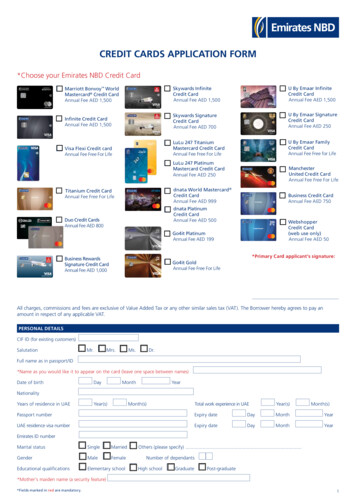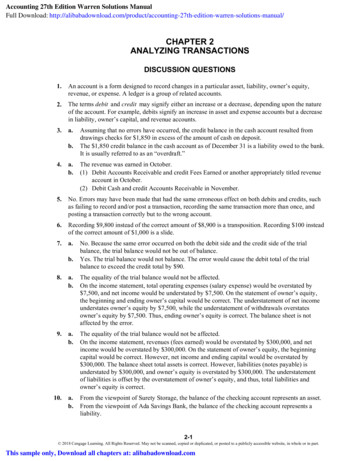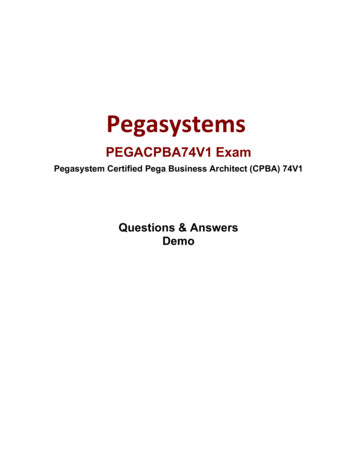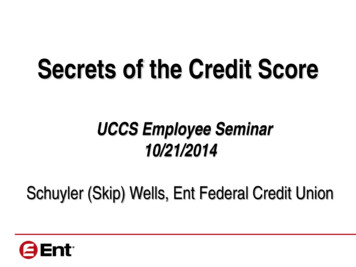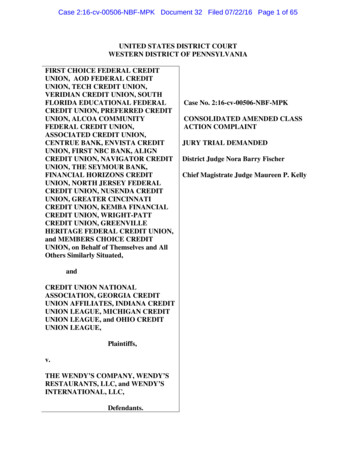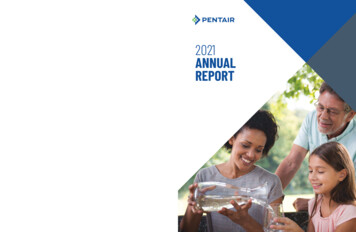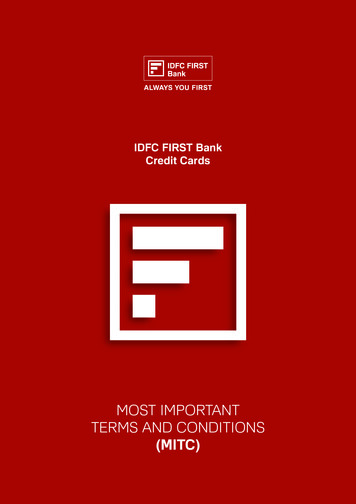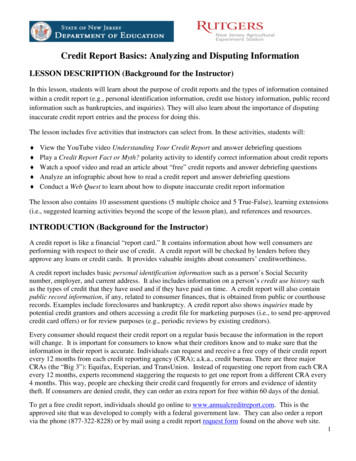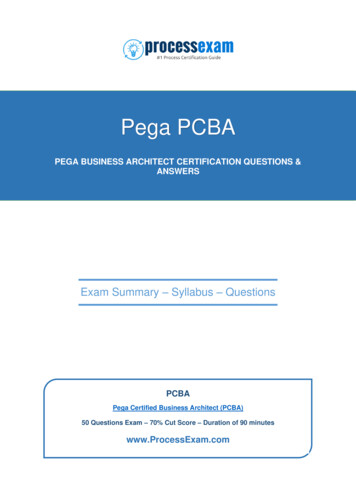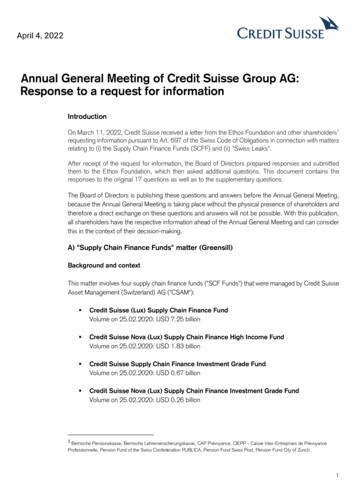
Transcription
April 4, 2022Annual General Meeting of Credit Suisse Group AG:Response to a request for informationIntroductionOn March 11, 2022, Credit Suisse received a letter from the Ethos Foundation and other shareholders1requesting information pursuant to Art. 697 of the Swiss Code of Obligations in connection with mattersrelating to (i) the Supply Chain Finance Funds (SCFF) and (ii) "Swiss Leaks".After receipt of the request for information, the Board of Directors prepared responses and submittedthem to the Ethos Foundation, which then asked additional questions. This document contains theresponses to the original 17 questions as well as to the supplementary questions.The Board of Directors is publishing these questions and answers before the Annual General Meeting,because the Annual General Meeting is taking place without the physical presence of shareholders andtherefore a direct exchange on these questions and answers will not be possible. With this publication,all shareholders have the respective information ahead of the Annual General Meeting and can considerthis in the context of their decision-making.A) "Supply Chain Finance Funds" matter (Greensill)Background and contextThis matter involves four supply chain finance funds ("SCF Funds") that were managed by Credit SuisseAsset Management (Switzerland) AG ("CSAM"): Credit Suisse (Lux) Supply Chain Finance FundVolume on 25.02.2020: USD 7.25 billion Credit Suisse Nova (Lux) Supply Chain Finance High Income FundVolume on 25.02.2020: USD 1.83 billion Credit Suisse Supply Chain Finance Investment Grade FundVolume on 25.02.2020: USD 0.67 billion Credit Suisse Nova (Lux) Supply Chain Finance Investment Grade FundVolume on 25.02.2020: USD 0.26 billion1 Bernische Pensionskasse, Bernische Lehrerversicherungskasse, CAP Prévoyance, CIEPP - Caisse Inter-Entreprises de PrévoyanceProfessionnelle, Pension Fund of the Swiss Confederation PUBLICA, Pension Fund Swiss Post, Pension Fund City of Zurich.1
April 4, 2022The SCF Funds invested in receivables related to production and trade transactions, such as, inparticular, accounts receivable from the delivery of goods and the provision of services, loans to financepurchases or to pre-finance future deliveries ("Trade Receivables"). For this purpose, the SCF Fundsacquired notes in which such Trade Receivables were securitized. These notes primarily had maturitiesof 90-270 days and were purchased at a discount to their nominal value, allowing the SCF Funds toearn interest. With these investments, the SCF Funds were able to offer a return to their investors in anenvironment of zero or negative interest rates. However, this return was not without risk, as TradeReceivables are not of the same quality as prime corporate or government bonds. The SCF Funds weretherefore intended only for institutional and professional investors that could handle this risk. In total,around 1,200 investors acquired shares in the SCF Funds (see supplementary question (i)).The SCF Funds sourced virtually all of the notes in which they invested through Greensill Capital UK("Greensill"). Greensill was considered the leading Trade Receivables securitization firm at the time.Greensill continuously acquired such receivables and securitized them into notes that it placed withvarious banks, institutional investors, and funds. The securitization process was structured in such a waythat the notes always embodied claims against third parties – the SCF Funds and ultimately theirinvestors therefore did not bear any "Greensill credit risk," but invested in claims against third partiesbacked by Trade Receivables. As part of the securitization, Greensill also arranged for the TradeReceivables to be insured under a credit insurance policy it had with Tokio Marine and other insurers, ifrequested by the purchasers (see supplementary question (ii)).On February 23, 2021, Greensill unexpectedly announced that Tokio Marine had not renewed its creditinsurance policy and that Greensill was therefore no longer able to insure new notes. The expiration ofthe insurance policy did not affect notes that had been issued with insurance coverage up to that point.However, without insurance coverage, it was impossible for Greensill to continue its operations, as themajority of notes had been sold with insurance coverage. Greensill therefore ceased operations as ofthe end of February 2021. This first forced the SCF Funds to stop issuing and redeeming fund unitsand then to initiate liquidation, as they could no longer purchase new notes, but could only liquidate thenotes they had previously purchased and pay their investors accordingly. During the liquidation, itbecame apparent that some of the debtors were unable to pay the claims underlying the notes by thematurity date (see supplementary question (iii)). Some of the debtors had assumed that they couldalways renew the short-term financing in a roll-over with Greensill and therefore had not made provisionsfor repayment. Moreover, the maturity date also coincided with the Coronavirus pandemic, which causedfinancial problems for some companies that made repayment impossible.CSAM has been taking all necessary steps to collect the outstanding amounts since March 2021. Insome cases, however, refinancing or sales of assets are not yet possible. For other companies, paymentplans have to be drawn up and financial compromises made or collateral enforced. CSAM has alsoreported the defaults to its credit insurer and filed corresponding claims. It is expected that litigation willbe necessary to enforce claims against individual debtors and the insurance companies, which may takearound five years.As of the end of February 2022, the Virtuoso Fund has paid out 65% of net assets to investors as perFebruary 25, 2021 and holds liquidity and liquid receivables equal to 5% of this amount. The High2
April 4, 2022Income Fund has paid out 63% and holds 7% liquidity and liquid receivables. The remaining amount(28% (see supplementary question (iv)) or 30%) comprises receivables from difficult debtors where theabove measures are necessary and insurance claims need to be made. Despite all efforts to assert theclaims against debtors and insurance companies, it can be assumed that investors in the Virtuoso Fundand the High Income Fund will suffer a loss. The percentage of the potential loss cannot be estimatedtoday as it depends on many factors beyond CSAM's control. In the case of the two investment gradefunds, which were limited to high-quality Trade Receivables and had correspondingly lower yields, allnotes were redeemed at nominal value (presuming the redemption took place before the maturity date,a minimal interest amount was deducted), which makes a correspondingly high liquidation distributionpossible (see supplementary question (v)).Supplementary question (i): What part of these investors were internally managed by CSG via discretionary mandate?Response:Approximately 12% of the funds' total assets were per 25.02.2021 managed under discretionarymandates by the Group.Supplementary question (ii): We understand that the acquirors ("Erwerber") are the SCF funds and that the latterrequested a third party insurance coverage. Please indicate the due diligence performed in respect ofthis insurance coverage.Response:As part of the "New Product Development Process," a due diligence questionnaire was completed. Thisprocess extended to the credit insurance that Greensill arranged. In particular, it was clarified whichinsurance companies had issued the policy and what risks were covered (credit default).However, not all of the notes in the SCF Funds were covered by credit insurance: Virtuoso Fund: In this fund, all Trade Receivables securitized in the notes were covered by thecredit insurance policies. High Income Fund: In this fund, the positions were generally not insured. However, where noteshad a rating lower than CCC, these notes were only acquired by this fund if the securitizedreceivables were covered by credit insurance. Investment Grade (Lie) Fund: In this fund, positions were insured where the debtor had a ratingof A- or lower. Investment Grade (Lux) Fund: In this fund, positions were insured where the debtor had a ratingof A- or lower.The waiver of insurance coverage and the connection between insurance and the rating of the noteswas disclosed in the fund prospectuses. The High Income Fund waived insurance coverage in order togenerate a higher return, but this was associated with a correspondingly higher risk – the investmentswith a rating of CCC represent a relatively large risk.Supplementary question (iii): Why was this default of debtors not covered by the insurance coverage (it is indicated abovethat the insurance coverage continued to apply to the claims in existence at the time the insurancecoverage as terminated (for the future))?3
April 4, 2022Response:If a debtor fails to pay, credit insurance does not pay automatically. The failure to pay must first bereported to the insurance company. If payment is still not made within the period specified in the policy,a full claim must be submitted to the insurance company. The insurance company then clarifies thefacts as it deems necessary and decides on payment. If an insurance company refuses to pay for aclaim, the only option is to take legal action. SCF Funds, in cooperation with Greensill Bank, havereported defaults covered by credit insurance in a timely manner and also filed formal claims in a timelymanner. To the extent that insurance companies fail to pay, CSAM will pursue the appropriate claimsthrough the courts on behalf of the SCF Funds. In parallel with the filing of claims with the insurancecompanies, the SCF Funds or CSAM must enforce their claims against the debtors for the purpose ofloss mitigation. Therefore, CSAM, on behalf of the SCF Funds, is currently filing claims with theinsurance companies and, if necessary, also taking action against them, but is also taking action againstthe debtors themselves to recover the outstanding amounts.In 2020, two Virtuoso Fund debtors defaulted on payments. In one case, the default was fully coveredby insurance payments. In the second case, around 96% was paid until the fund was liquidated.However, a single member of the insurance syndicate refuses to pay its share. Here, the dispute is stillongoing. The experience with these two claims showed CSAM in 2020 that credit insurance worked inpractice.Additional question (iv): Please explain this figure (it is indicated above that Virtuoso has reimbursed 65% and holds 5%in liquid assets).Response:The difference is primarily due to the effect of FX hedging as well as ongoing costs charged to thefunds.Supplementary question (v): Does this mean that the investors in the "investment grade" funds will not suffer a loss?Response:Despite the full redemption of the notes, it is anticipated that investors in these funds will not receiveback quite 100% of NAV as per 25.02.2021, as certain costs associated with the liquidation will becharged to the SCF Funds. However, we currently expect that investors will receive at least 99% of thisNAV.The large difference between the investment grade funds on the one hand and the Virtuoso Fund andthe High Income Fund on the other hand in terms of repayment is due to the different quality of theirinvestments. As described in the corresponding prospectuses, the Virtuoso Fund and the High IncomeFund invested in Trade Receivables with higher risks, whereby the High Income Fund also waivedinsurance to the extent mentioned above. In contrast, the investment grade funds invested in loans ofhigher quality and with lower risk. However, these differences in risk were also reflected in the returns,which were lowest for the investment grade funds and highest for the High Income Fund. Investorswere thus able to choose between different risk-return profiles.4
April 4, 2022A.1 Responses to the questions to the Board of Directorsa. Establishment of the business relationship with the Greensill GroupQuestion 1:How was the business relationship with the Greensill Group established?Response:In March 2016, Greensill contacted CSAM and presented the idea of a fund with securitized TradeReceivables. Lex Greensill, CEO of Greensill, presented the concept of such a fund himself andexplained the services Greensill could provide to operate a fund. Greensill offered to enter into aWarehousing Agreement with CSAM for this purpose. Pursuant to this Warehousing Agreement,Greensill would locate suitable debtors, acquire receivables, securitize them, and structure the notes,which would then be sold to the new SCF fund. Part of the services to be provided by Greensill wasalso the monitoring of the debtors as well as the insurance of the receivables.Question 2:In particular, what controls were in place when the business relationship was established, wereescalation procedures carried out in accordance with internal guidelines, and who validated the decisionto establish the business relationship with the Greensill Group?Response:After extensive discussions with Greensill, CSAM decided to pursue a SCF fund project and developsuch a product. In the Asset Management area, a new product must go through an approval processdefined in the "Asset Management new products/strategic initiatives" policy. This process begins withthe development of a business plan, which is then submitted to the Product Development ManagementTeam ("PDM Team"). The PDM Team then prepares a New Product Memorandum, which analyzes andpresents in detail the financial, organizational and legal conditions of the new product as well as theassociated risks. The product described in the Memorandum must then be reviewed by various functionsin CSAM, all of which make recommendations, such as, in particular, Compliance, Legal, RiskManagement, the COO of the business unit concerned (as the person responsible for business risks),and Sales (see supplementary question (i)). The decision is then made by the responsible Product Boardon the basis of the New Product Memorandum and the recommendations of the individual bodies. Inthe case of the Virtuoso Fund, this decision was made by the Swiss & EMEA Product Board.Following approval, the Virtuoso Fund was launched on April 24, 2017. As this SCF fund was wellreceived by investors, a second SCF fund, the "High Income Fund," was developed, which differed fromthe Virtuoso Fund in that it took on greater risks – without insurance for most of the notes – but alsogenerated higher returns. The fund also went through the New Product Development process and waslaunched on May 7, 2018. The two investment grade funds were launched on December 17, 2018,and January 22, 2020, after also being approved in the New Product Development process – thesefunds had lower yields and risks because they invested only in high-quality receivables.The New Product Development process also ensured that the securitization was structured in such away that the claims of the SCF Funds against the third-party debtors of the securitized receivables werenot jeopardized by a potential bankruptcy of Greensill. Following the product development process, aprospectus was also prepared for the SCF Funds. This prospectus explicitly stated that CSAM took apassive role in managing the fund and had outsourced the selection and monitoring of debtors to a thirdparty service provider. The prospectus did not mention Greensill, however, because CSAM wanted toremain free to select third-party providers (see supplementary question (ii)).5
April 4, 2022Supplementary question (i): What was the assessment of the internal audit as regards the 4 funds?Response:Internal Audit made no negative findings with regard to the SCF Funds as part of the "New ProductDevelopment” process.Supplementary question (ii): Please explain this sentence and the reason for not mentioning Greensill in the prospectusof the funds.Response:The fund prospectuses expressly stated that CSAM took a passive role in managing the fund and hadoutsourced the selection and monitoring of debtors to a third-party service provider. The Virtuoso Fundprospectus contained the following clause (the prospectuses of the other funds contained virtuallyidentical clauses):"The Subfund will primarily acquire Notes from the distributor(s) of the Issuer under one or severalwarehouse facility arrangement(s). Pursuant to the terms of those warehouse facility arrangement(s),the Subfund undertakes to buy the Notes issued from time to time by the Issuer subject to (i) theavailability of sufficient cash at the level of the Subfund and (ii) the Subfund's risk diversification rulesas further described below under "Risk Diversification Rules". The Portfolio Manager will therefore notexercise discretionary investment management powers in respect of the Notes at the time of theiracquisition and throughout the period of time they remain assets of the Subfund, it being understoodhowever that the Notes acquired under the warehouse facility arrangement(s) will always meet certainpredetermined criteria."This disclosed the outsourcing of essential functions to a third-party service provider to all investors.However, CSAM did not want to mention Greensill by name in the prospectus because it wanted tokeep open the possibility of acquiring notes from other service providers as well. If CSAM had specificallymentioned Greensill in the prospectus as the provider of the notes, Greensill would have obtained amonopoly position. CSAM wanted to avoid this in the interest of investors.Question 3:At the time the business relationship with the Greensill Group was established, what relationships existedbetween the various business units of Credit Suisse Group, on the one hand, and Mr. Greensill and thebusiness units controlled by him, on the other?Response:When Greensill contacted CSAM about the new fund, and throughout the time this project was beingdeveloped, there were no other business relationships between CS Group and the Greensill Group.At the beginning of September 2020, CS Group Investment Banking and Greensill agreed to assumea mandate to conduct a private placement of shares in Greensill. At the time, the market assumedGreensill was valued at approximately USD 7 billion and Greensill intended to place approximately 20%of its shares to raise liquidity to expand its business, with an IPO also being considered. In connectionwith the mandate, Credit Suisse Investment Banking provided Greensill with a USD 140 million loan tobe repaid from the proceeds of the share placement (see supplementary question (i)). When assumingthis mandate and also when granting the loan, it was ensured that there was no exchange or influencebetween CSAM and CS Investment Banking – so-called "Chinese Walls" applied (see supplementaryquestion (ii)). The loan was granted in early November, but there was no private placement or IPO (seesupplementary question (iii)). The loan did not affect the SCF Funds as it was granted by CS InvestmentBanking. Information about banking relationships with natural persons cannot be provided due to Swissbanking secrecy laws.6
April 4, 2022Supplementary question (i): Was there any exception to policy to grant this loan ? In particular, was there any question fromCS regarding the audit firm of Greensill and why Deloitte, KPMG and BDO refused the mandate?Response:Greensill was audited by auditing companies of the Nexia Group. The Australian holding company wasaudited by Nexia Sydney. In contrast, the English Greensill Capital Ltd. was audited by SafferyChampness, an English member of the Nexia Group. Saffery Champness was the ninth largest auditingcompany in England at the time. In the context of the credit decision, this auditing company wasconsidered to be sufficiently qualified. The credit decision was granted within the framework of theapplicable policies that apply to credits.Supplementary question (ii): Does this mean that the compliance/liquidity issues which occurred in March 2020 (seeQuestion 6 below) were not taken into account when deciding to extend the loan and assist Greensill inthe IPO? How does the Credit Suisse ensure a "consolidated risk overview" in respect of clients servedby several business lines?Response:In March 2020, the Virtuoso Fund and the High Income Fund saw very heavy redemptions of fundcertificates, as many investors tried to increase their cash holdings at the beginning of the Coronaviruscrisis and sold fund units on a large scale. As a result, the two funds were close to closure in March2020, as they no longer had sufficient liquidity to make payouts on further redemptions of fund units.This problem had nothing to do with Greensill, but was due to the particular market situation in March2020. The funds held notes, most of which had maturities of 90-270 days. In addition to the notes,they held a liquidity reserve that was sufficient to cover redemptions in normal market situations.However, in March 2020, redemptions exceeded all previously experienced figures many times over.At the same time, it was not possible to sell notes in the secondary market because the market wasilliquid at that time. If a fund can no longer cover redemption requests from existing liquidity or the saleof assets, it must close to ensure that all investors are treated equally. If there had been furtherredemption requests or if SoftBank had not invested, the SCF Funds would have most likely been forcedto close for this reason. The liquidity problem only affected the funds themselves, not Greensill, sinceGreensill only delivered the notes and had to monitor the debtors, but had no obligation to redeem notesearly. Therefore, the problem faced by the SCF Funds in March 2020 did not affect the assessment ofGreensill with respect to placing shares or extending the loan.Supplementary question (iii): Please explain why the credit was extended despite the fact that the IPO was not launched.Please explain why the IPO was not launched. Please explain the process which led to the approval ofthe credit in September despite the fact that the Greensill-related funds had a serious liquidity problemin March 2020 (see Question 6 below).Response:The loan was granted with a view to the planned raising of equity capital through the placement ofshares. The aim of such loans is to provide liquidity to the company already prior to the placement ofshares in order to bridge the time up to the placement of shares and the corresponding receipt of liquidity(these loans are therefore also referred to as "pre-placement bridge loans"). If a loan is granted inconnection with the planned placement of shares, there is a risk that the share placement will not takeplace and that the loan cannot be repaid from the proceeds of this transaction. Therefore, CSG alsorequired collateralization of this loan – Greensill had to pledge various assets as security. In Greensill'scase, the share placement did not actually take place. CSG is therefore currently realizing the collateralprovided.The intended placement of shares did not take place because the environment for share placements byfinancial companies became more difficult towards the end of 2020 and because investors were notprepared to acquire shares at a valuation of USD 7 billion. The parties therefore postponed the7
April 4, 2022placement of shares to the first quarter of 2021, but due to the collapse of Greensill, the transactioncould then not be realized.As shown above in the response to supplementary question (ii), the liquidity problem of the SCF Fundshad no direct relation to Greensill, i.e. was due to the market situation and the level of liquidity reservesof the funds themselves. Accordingly, this problem had no influence on the decisions to place sharesof and grant a loan to Greensill.b. Business relationship with the Greensill GroupQuestion 4 (a):What was Credit Suisse Group's role during the business relationship with the Greensill Group withrespect to: holding assets for business units of the Greensill Group?Response:Credit Suisse Group did not hold any assets for the Greensill Group.Question 4 (b):What was the role of Credit Suisse Group during the business relationship with the Greensill Group withrespect to: the financing of business units of the Greensill Group?Response:In response to this question, please refer to question 3. There was no further funding.Question 4 (c):What was the role of Credit Suisse Group during the business relationship with the Greensill Group withrespect to: distributing financial products to clients that involved exposure to Greensill?Response:As explained above, there was no exposure to Greensill for the SCF Funds. Investors bore the riskassociated with Trade Receivables, but no credit risk with respect to Greensill – the receivables were allagainst third-party entities.The shares of the SCF Funds were purchased by a total of 1,200 institutional or professional investors(Qualified Investors). Approximately 57% were subscribed by Private Banking clients who were QualifiedInvestors (see supplementary question (i)). The remaining shares were sold directly by CS InvestmentBanking or by CSAM to third-party investors who did not have a Private Banking relationship with thebank – essentially, these were institutional clients.CS Group never sold shares or debt securities of Greensill itself. The placement of shares mentionedunder question 3 was never carried out.Supplementary question (i): Please indicate the breakdown of these private banking clients between (i) managed clients,(ii) advisory clients and (iii) execution only clients. Is the 57% expressed in terms of number of clientsor in terms of AUM/interests in the funds?Response:The volume of funds (AuM) placed with Private Banking clients (in total, approximately 69% of the totalvolume of SCF Funds as of 25.02.2021) broke down as follows: Asset management mandates: approx. 12%Execution-only and advisory clients: approx. 57%.Question 5:What measures were taken to identify and manage conflicts of interest related to these various roles?Response:Conflicts of interest could only arise in September 2020, when CS Group started preparing the shareplacement or a possible IPO and granted a loan. Possible conflicts of interest were managed by8
April 4, 2022observing so-called "Chinese walls" between CSAM and CS Investment Banking both in the mandatefor the placement of shares and in the granting of the loan. Conflicts of interest were also avoided bylimiting the Investment Bank's activities to issues unrelated to the SCF Funds, i.e. which did not burdenthem or conflict with the investments of the SCF Funds.Question 6:Were there any transactions during the course of the business relationship with Greensill that requiredexceptions to policies? If so, which governing bodies approved these exceptions?Response:No exceptions to policies were granted during the initiation of the business relationship with Greensilland the structuring of the SCF Funds. However, there were later violations of policies in the followingrespects. In March 2020, the Virtuoso Fund and the High Income Fund saw very strong redemptions offund certificates, as a very large number of investors tried to increase their liquidity at the startof the Coronavirus crisis and sold securities on a large scale. As a result, the two funds wereclose to closure in March 2020, as they no longer had sufficient liquidity to make payouts onfurther redemptions. At that point, SoftBank agreed to invest USD 1.5 billion in the VirtuosoFunds. However, SoftBank required the signing of a side letter under which CSAM wouldcommit to purchase notes for the SCF Funds only through Greensill in the future. The drivingforce for SoftBank's investment and also for SoftBank's demand for a side letter was probablythe fact that SoftBank held a large stake in Greensill and wanted to promote its business in thisway. After the SCF Funds had acquired all the notes they held at the time from Greensillanyway, the side letter was signed. However, this side letter violated the requirement to treatinvestors equally. When CS Group learned of this, an independent investigation was immediatelyconducted by the law firm Cahill (see supplementary question (i)), which clarified the facts ofthe matter. The problem was also immediately reported to FINMA (see supplementary question(ii)) and the side letter with SoftBank was cancelled, resulting in SoftBank withdrawing theirmoney again. The Head of CSAM Switzerland/EMEA was subject to disciplinary sanctions,which resulted, among other things, in a severe reduction of his compensation. In addition,action was also taken against other individuals who had engaged in misconduct in connectionwith the side letter. Following the side letter matter, Compliance investigated not only the procedure for concludingside letters, but also the financing of companies related to SoftBank by the SCF Funds anddemanded an overall reduction of this exposure (see supplementary question (iii)). To this end,CS Group set targets or limits for CSAM to meet by December 31, 2020. After CSAM was notable to meet these limits within the deadline because it could not sell the corresponding notes,the deadline was extended by the Executive Board until March 31, 2021 (see additionalquestion (iv)). The extension until this date was made because by this date most of the notesrelated to debtors that were close to SoftBank matured and therefore the waiver of the purchaseof new notes from these debtors would already lead to compliance with these limits. The review of the entire Greensill matter as of March 2021 showed that individual managersand employees could have averted the reputational damage and economic failure if they hadconducted themselves in prior years more appropriately. Some of this conduct was deemed tobe a violation of policies on management and supervision, which had the consequences for themanager
reported defaults covered by credit insurance in a timely manner and also filed formal claims in a timely manner. To the extent that insurance companies fail to pay, CSAM will pursue the appropriate claims through the courts on behalf of the SCF Funds. In parallel with the filing of claims with the insurance

